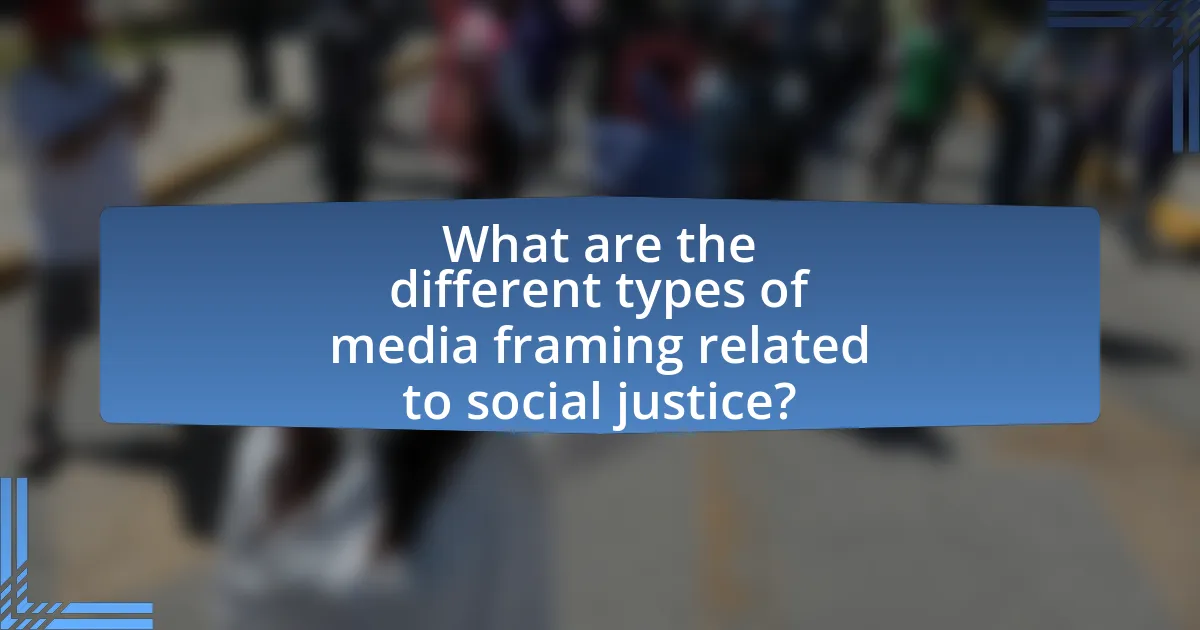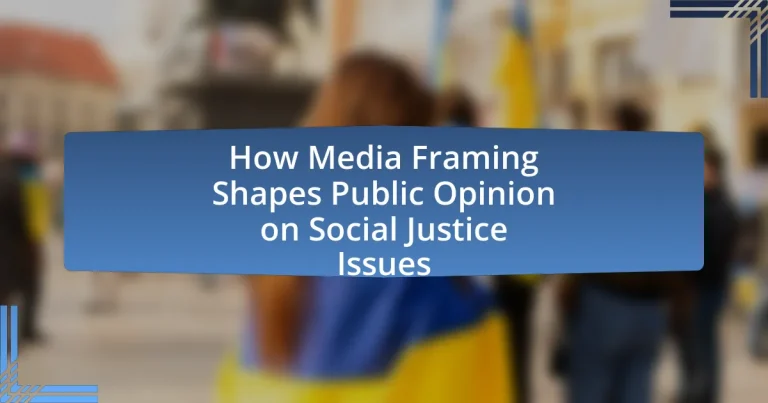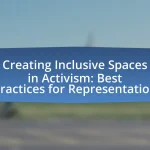The article examines how media framing significantly influences public perception of social justice issues by shaping narratives and contexts. It discusses key concepts of media framing, including frame selection and resonance, and highlights the role of language in guiding audience interpretation. The article also categorizes different types of media framing, such as issue, episodic, thematic, and conflict framing, and explores the impact of framing on public discourse, polarization, and activism. Additionally, it provides strategies for individuals to critically engage with media framing and promote balanced narratives, emphasizing the importance of media literacy in understanding social justice issues.

How does media framing influence public perception of social justice issues?
Media framing significantly influences public perception of social justice issues by shaping the narrative and context in which these issues are presented. When media outlets emphasize certain aspects of a social justice issue, such as focusing on individual stories of victims or highlighting systemic inequalities, they can evoke specific emotional responses and guide public opinion. For instance, research by Entman (1993) demonstrates that framing can affect how audiences interpret events, leading to varying levels of support for policies related to social justice. Additionally, studies show that media framing can reinforce stereotypes or challenge them, ultimately impacting public discourse and policy decisions.
What are the key concepts of media framing?
Media framing involves the presentation and interpretation of information in a way that influences audience perception. Key concepts include frame selection, which refers to the specific angles or perspectives chosen to highlight certain aspects of an issue, and frame resonance, which indicates how well a frame aligns with the audience’s pre-existing beliefs and values. Additionally, the concept of issue framing emphasizes how the context and language used can shape the understanding of social justice issues, affecting public opinion and discourse. Research by Entman (1993) highlights that framing can significantly alter the perceived importance of issues, demonstrating its power in shaping societal narratives.
How does media framing define social justice issues?
Media framing defines social justice issues by shaping the narrative and context in which these issues are presented to the public. This framing influences how audiences perceive the significance, causes, and potential solutions to social justice matters. For example, research by Entman (1993) highlights that the way media emphasizes certain aspects of a story can lead to different interpretations and responses from the audience. When media outlets focus on systemic inequality, they can foster a greater understanding of social justice issues, whereas framing them as isolated incidents may minimize their perceived importance. Thus, media framing plays a crucial role in guiding public discourse and opinion on social justice topics.
What role does language play in media framing?
Language plays a crucial role in media framing by shaping how information is presented and interpreted by audiences. The choice of words, tone, and context influences perceptions and attitudes toward social justice issues. For example, using terms like “protesters” versus “rioters” can evoke different emotional responses and align public opinion with specific narratives. Research by Entman (1993) highlights that framing involves selection and salience, where language emphasizes certain aspects of an issue while downplaying others, ultimately guiding audience understanding and reaction. This demonstrates that language is not merely a tool for communication but a powerful mechanism that can sway public opinion on critical social justice matters.
Why is media framing important in shaping public opinion?
Media framing is important in shaping public opinion because it influences how issues are perceived and understood by audiences. The way media presents information—through specific language, images, and context—can highlight certain aspects of a story while downplaying others, thereby guiding public interpretation. For instance, research by Entman (1993) demonstrates that framing can affect the salience of particular issues, leading audiences to prioritize certain viewpoints over others. This selective emphasis can significantly impact public attitudes and behaviors regarding social justice issues, as seen in coverage of movements like Black Lives Matter, where framing can either promote empathy and support or foster misunderstanding and resistance.
How does framing affect audience interpretation of social justice narratives?
Framing significantly influences audience interpretation of social justice narratives by shaping the context and perspective through which information is presented. When media outlets emphasize specific aspects of a social justice issue, such as focusing on individual stories of hardship versus systemic causes, they guide audience perceptions and emotional responses. For instance, research by Entman (1993) highlights that framing can lead audiences to attribute responsibility differently, affecting their support for policies or actions related to social justice. This demonstrates that the way narratives are framed can alter public understanding and engagement with social justice issues, ultimately impacting advocacy and policy outcomes.
What psychological mechanisms are involved in media framing?
Media framing involves several psychological mechanisms, including priming, schema activation, and cognitive dissonance. Priming occurs when exposure to certain media frames influences the accessibility of related thoughts and feelings, thereby shaping audience perceptions and responses. Schema activation refers to the mental structures that help individuals organize and interpret information; specific frames can activate particular schemas that guide how people understand social justice issues. Cognitive dissonance arises when individuals encounter information that conflicts with their existing beliefs, leading them to either adjust their views or rationalize the new information to reduce discomfort. These mechanisms collectively demonstrate how media framing can significantly impact public opinion on social justice issues by influencing perceptions, interpretations, and emotional responses.

What are the different types of media framing related to social justice?
Media framing related to social justice can be categorized into several types, including issue framing, episodic framing, thematic framing, and conflict framing. Issue framing focuses on specific social justice topics, such as racial inequality or gender discrimination, highlighting particular aspects to shape public perception. Episodic framing presents individual stories or cases, often personalizing social justice issues, which can evoke emotional responses and influence public empathy. Thematic framing, in contrast, provides a broader context, emphasizing systemic factors and trends, which can lead to a more comprehensive understanding of social justice issues. Conflict framing highlights opposing viewpoints or struggles, often portraying social justice as a battleground between different groups, which can polarize public opinion. These framing types significantly impact how audiences interpret and engage with social justice issues, as evidenced by studies showing that different frames can lead to varying levels of public support for policies aimed at addressing social injustices.
How do different media outlets frame social justice issues?
Different media outlets frame social justice issues by emphasizing specific narratives, language, and perspectives that shape public perception. For instance, mainstream media often highlights systemic inequalities and institutional failures, while alternative media may focus on grassroots movements and personal stories of marginalized individuals. Research by Entman (1993) indicates that framing influences how audiences interpret social justice topics, as the selection and salience of certain aspects can lead to varying public responses. Additionally, studies show that media framing can affect policy support; for example, when social justice issues are framed in terms of human rights, public support for related policies tends to increase.
What are the common framing techniques used in news reporting?
Common framing techniques used in news reporting include selection and emphasis, which shape how stories are perceived. Selection involves choosing specific facts or angles to highlight, while emphasis refers to the way certain aspects are presented to influence audience interpretation. For example, a report on a protest may frame it as a “peaceful demonstration” or a “violent riot,” significantly affecting public perception. Research by Entman (1993) in “Framing: Toward Clarification of a Fractured Paradigm” illustrates that framing can alter the audience’s understanding and emotional response to social issues, thereby impacting public opinion on social justice matters.
How does framing differ between traditional and social media?
Framing in traditional media typically involves a top-down approach where editors and journalists select and present information to shape public perception, often adhering to established narratives and gatekeeping practices. In contrast, social media allows for a bottom-up approach, where users can create, share, and modify content, leading to diverse perspectives and rapid dissemination of information. This difference is evidenced by the ability of social media platforms to amplify grassroots movements, such as the Black Lives Matter movement, which gained momentum through user-generated content and viral sharing, contrasting with traditional media’s slower, more controlled coverage.
What impact does framing have on public discourse?
Framing significantly influences public discourse by shaping how issues are perceived and discussed. When media outlets present information through specific frames, they highlight certain aspects while downplaying others, which can lead to altered public understanding and opinion. For instance, research by Entman (1993) demonstrates that framing can affect the salience of particular issues, thereby guiding public attention and interpretation. This selective emphasis can mobilize support or opposition for social justice issues, as seen in the framing of protests or policy debates, ultimately impacting societal attitudes and actions.
How does media framing contribute to polarization on social justice issues?
Media framing contributes to polarization on social justice issues by shaping the narrative and influencing public perception through selective emphasis on certain aspects of a story. When media outlets highlight specific angles, such as focusing on extreme viewpoints or emotional appeals, they can reinforce existing biases and create an “us versus them” mentality among audiences. Research by Entman (1993) indicates that framing can lead to divergent interpretations of the same issue, thereby exacerbating divisions. For instance, coverage of protests may frame participants as either heroes or villains, which can polarize public opinion and hinder constructive dialogue.
What are the implications of framing for activism and advocacy?
Framing significantly influences activism and advocacy by shaping how issues are perceived and prioritized by the public. Effective framing can mobilize support, alter public perceptions, and influence policy outcomes. For instance, research by Entman (1993) highlights that the way issues are framed in media can determine which aspects are emphasized, thereby guiding public discourse and action. Additionally, studies show that frames that resonate with the audience’s values can enhance engagement and participation in advocacy efforts, as seen in campaigns like Black Lives Matter, which effectively framed systemic racism as a critical social issue. Thus, the implications of framing are profound, as it can either empower movements or undermine their effectiveness based on how narratives are constructed and communicated.

How can individuals critically engage with media framing on social justice issues?
Individuals can critically engage with media framing on social justice issues by analyzing the language, imagery, and narratives used in media representations. This involves recognizing how specific words and visuals can shape perceptions and influence public opinion. For instance, studies have shown that the framing of protests as “riots” versus “demonstrations” can significantly alter audience perceptions of legitimacy and urgency (Entman, 1993). By questioning the underlying assumptions and biases in media portrayals, individuals can better understand the implications of framing on social justice discourse and advocate for more equitable representations.
What strategies can be used to analyze media framing?
To analyze media framing, researchers can employ content analysis, discourse analysis, and framing analysis. Content analysis systematically examines media texts to identify patterns in how issues are presented, such as the frequency of specific themes or language used. Discourse analysis focuses on the language and communication strategies within media narratives, revealing underlying ideologies and power dynamics. Framing analysis specifically investigates how particular aspects of an issue are emphasized or downplayed, influencing audience perceptions. These strategies are validated by studies like “Framing and Public Opinion: The Role of Media in Shaping Attitudes” by Entman, which demonstrates how different frames can lead to varying public responses to social justice issues.
How can one identify biased framing in news coverage?
One can identify biased framing in news coverage by analyzing the language, tone, and context used in reporting. Biased framing often manifests through selective emphasis on certain facts while downplaying others, which can shape public perception. For instance, a study by Entman (1993) highlights that framing involves highlighting specific aspects of an issue, thereby influencing how audiences interpret it. Additionally, the choice of words can indicate bias; emotionally charged language may signal an attempt to sway opinion rather than present objective information. Recognizing these patterns allows individuals to discern potential biases in news narratives.
What tools are available for assessing media framing effects?
Content analysis is a primary tool for assessing media framing effects, allowing researchers to systematically evaluate how specific themes and narratives are presented in media. This method involves coding and analyzing media content to identify framing techniques, such as the use of language, imagery, and context. Additionally, surveys and experiments can be employed to measure audience perceptions and reactions to different media frames, providing insights into how framing influences public opinion. Studies, such as those conducted by Entman (1993) and Gamson & Modigliani (1989), demonstrate the effectiveness of these tools in revealing the impact of media framing on audience interpretation and attitudes toward social justice issues.
What best practices can enhance media literacy regarding social justice issues?
Best practices to enhance media literacy regarding social justice issues include promoting critical thinking skills, encouraging diverse media consumption, and providing education on media production techniques. Critical thinking skills enable individuals to analyze and evaluate media messages, fostering a deeper understanding of social justice narratives. Encouraging diverse media consumption exposes individuals to various perspectives, which is essential for comprehending the complexities of social justice issues. Education on media production techniques helps individuals recognize how framing, language, and imagery influence public perception, thereby equipping them to discern bias and misinformation. These practices collectively empower individuals to engage thoughtfully with media related to social justice, ultimately shaping informed public opinion.
How can individuals promote balanced narratives in media consumption?
Individuals can promote balanced narratives in media consumption by actively seeking diverse sources of information and critically evaluating the content they engage with. This approach encourages exposure to multiple perspectives, which is essential for understanding complex social justice issues. Research indicates that media framing significantly influences public opinion; for instance, a study by Entman (1993) highlights how the framing of news can shape perceptions and attitudes. By diversifying their media intake and questioning biases, individuals can counteract the effects of narrow narratives and contribute to a more informed public discourse.
What role does education play in understanding media framing?
Education plays a crucial role in understanding media framing by equipping individuals with critical thinking skills necessary to analyze and interpret media messages. Through education, individuals learn to recognize biases, identify framing techniques, and understand the implications of language and imagery used in media. Research indicates that higher levels of education correlate with increased media literacy, enabling individuals to discern how framing influences public perception and opinion on social justice issues. For instance, studies show that educated audiences are more likely to question the motives behind media narratives and seek diverse perspectives, thereby fostering a more nuanced understanding of complex social issues.


